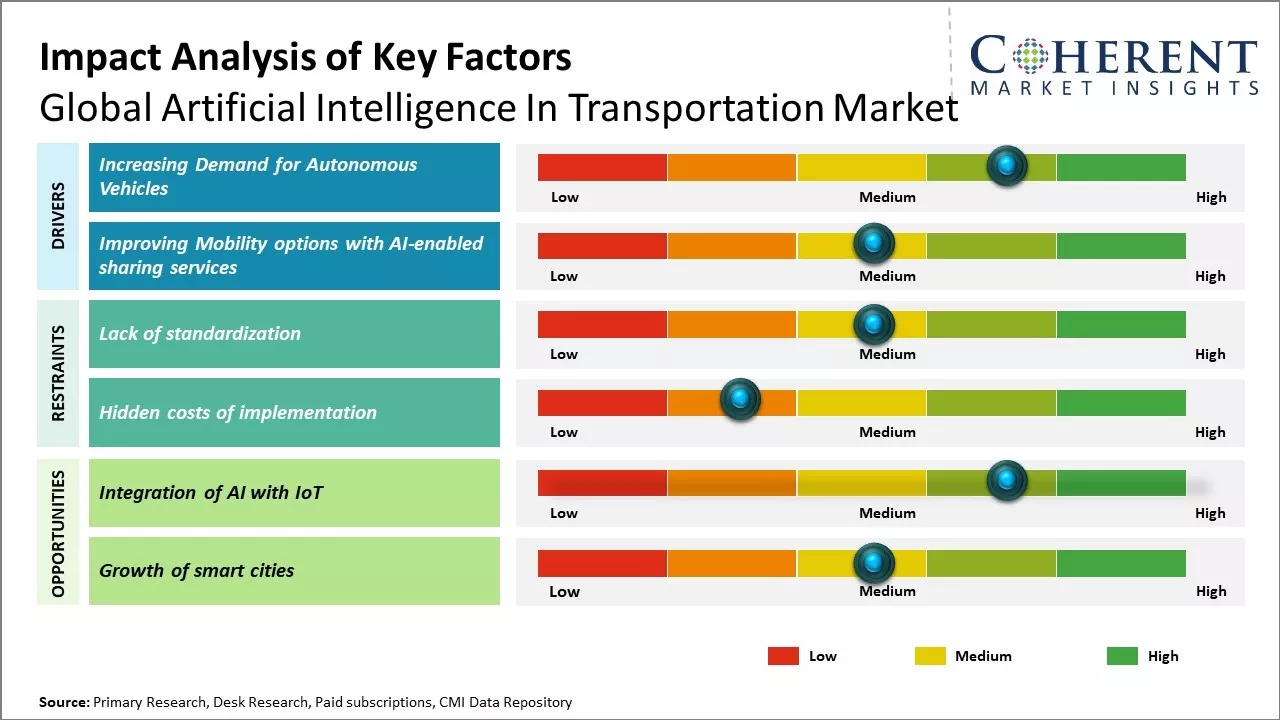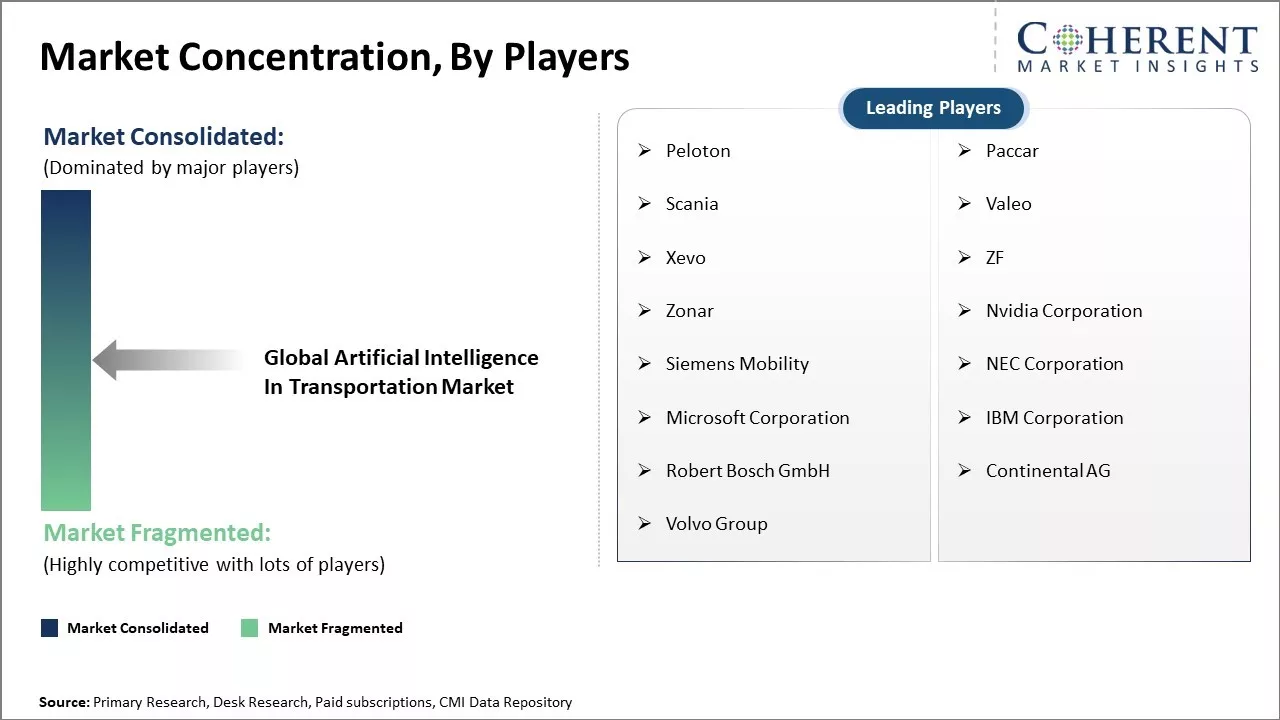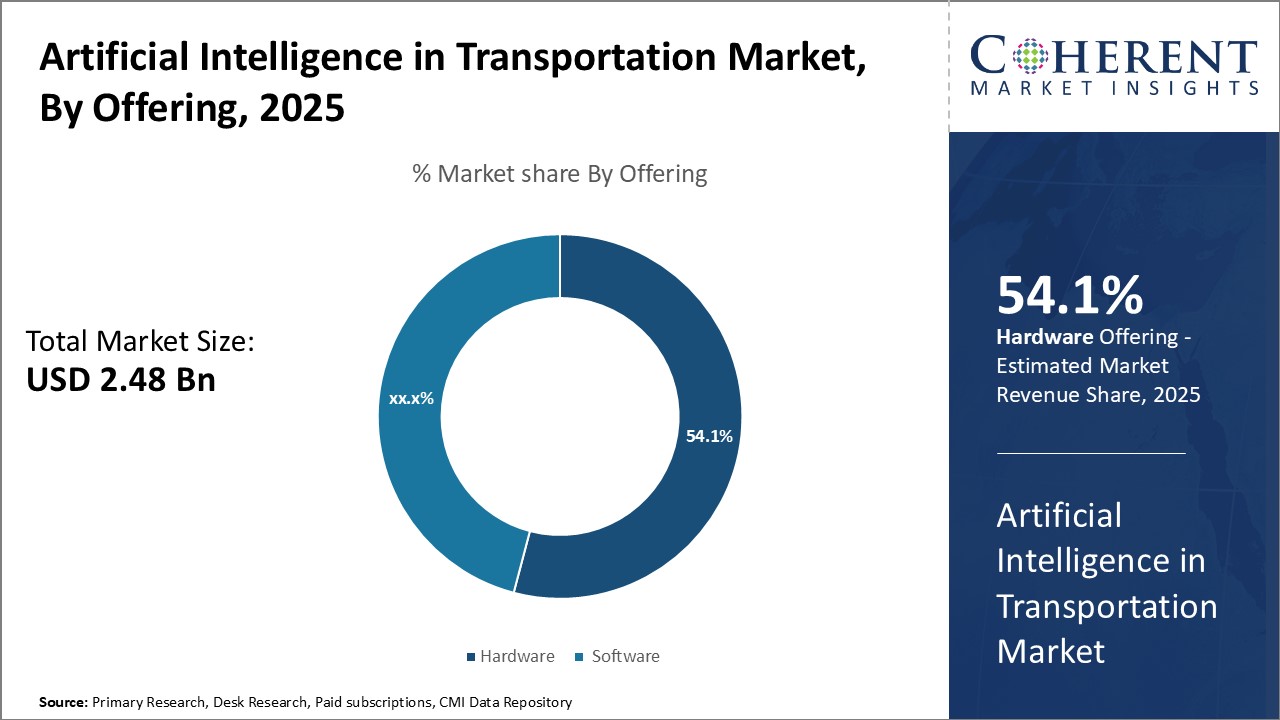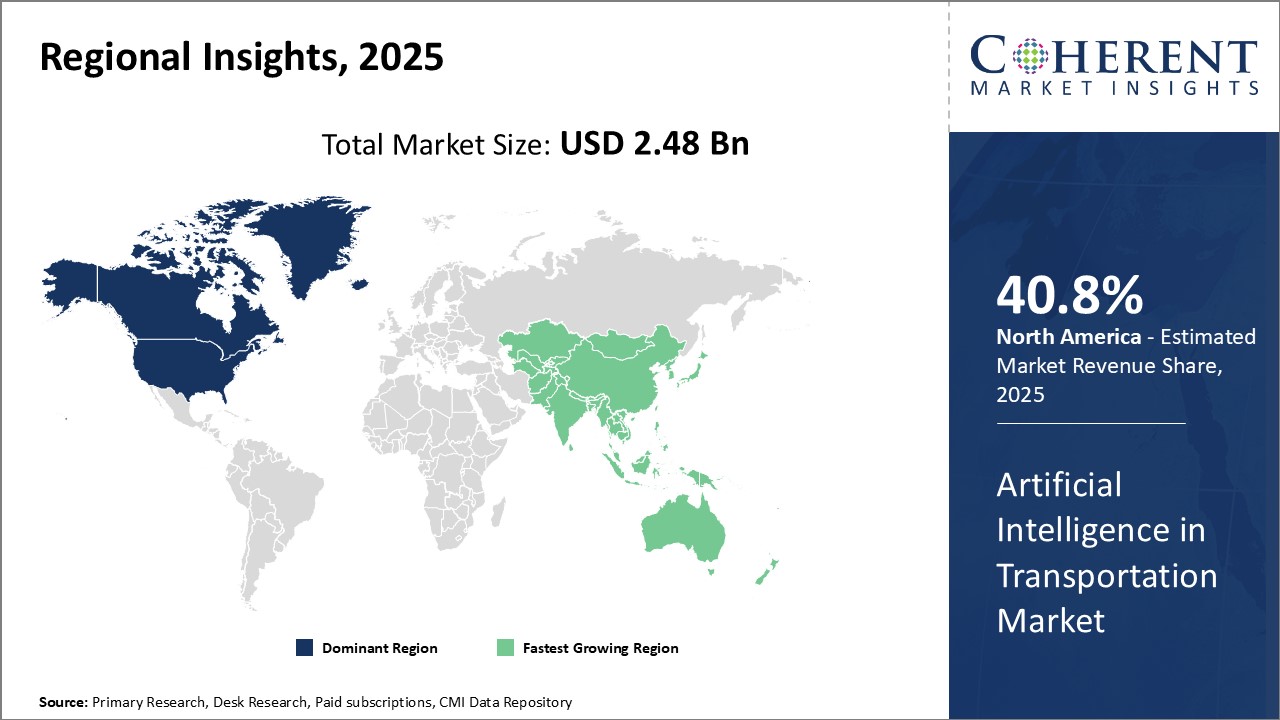Artificial Intelligence In Transportation Market Size and Trends
Global artificial intelligence in transportation market is estimated to be valued at US$ 2.48 Bn in 2025 and is expected to reach US$ 7.78 Bn by 2032, exhibiting a compound annual growth rate (CAGR) of 17.7% from 2025 to 2032.

Discover market dynamics shaping the industry: Download Free Sample
One of the major trends in the global artificial intelligence in transportation market is increasing adoption of autonomous vehicles. Automakers and technology companies are investing heavily in research and development of self-driving vehicles. These are focusing on developing advanced AI systems that can process data from sensors to detect objects and navigate through traffic without human intervention. The rise of connected and autonomous vehicles can transform transportation and boost demand for AI technologies in applications such as advanced driver assistance systems, autonomous passenger cars, and commercial vehicles. With further technological advancements, autonomous vehicles are poised to become mainstream over the next decade.
Increasing Demand for Autonomous Vehicles
The transportation sector is rapidly embracing automation technology due to growing demand for autonomous vehicles. Due to continuous advancements in artificial intelligence and its integration in self-driving features, people prefer driverless vehicles. The freedom and flexibility provided by autonomous driving attracts many people. As people does not need to drive themselves, they can utilize travel time productively for work, rest or entertainment. This is especially valuable for growing elderly population who face challenges in operating vehicles.
Autonomous technology makes travel safer and more efficient. Automated vehicles minimize human error, thus, preventing majority of road accidents globally that occurs due to distraction or drunk driving. These can also communicate with each other to optimize traffic flow and reduce congestion. With AI-based navigation assistance, drive time and energy consumption is being cut down substantially. Leading automotive companies and tech giants are heavily investing to build fully autonomous cars that can handle all aspects of driving without human intervention. While the technology still needs to progress further to achieve level 5 automation, it is anticipated that autonomous vehicles will become mainstream and reshape the future of transportation.
For instance, in October 2023, Amazon, a multinational technology company that focuses on e-commerce, cloud computing, digital streaming, and artificial intelligence launched Automated Vehicle Inspection (AVI), a cutting-edge AI technology that is designed to ensure the safety and reliability of its delivery vans by detecting even the smallest anomalies, such as tire issues or body damage, before these become on-road problems.
Market Concentration and Competitive Landscape

Get actionable strategies to beat competition: Download Free Sample
Improving Mobility options with AI-enabled sharing services
Growing popularity of mobility-on-demand services like ridesharing and vehicle leasing has boosted adoption of AI technologies in transportation. These shared mobility services offer flexibility and affordability, thus, providing easy access to transportation when needed without getting private vehicle ownership. Startups and tech companies are leveraging AI to optimize shared fleets, facility demand-responsive operations and improve customer experience. By using predictive algorithms, autonomous vehicles can be dispatched efficiently based on short-term usage patterns. AI is also enhancing routing and navigation, thus, managing vehicle repositioning and payment settlements seamlessly.
This transition to shared platform-based models is fundamentally reshaping consumer transportation behaviour. It helps to address mobility needs of millennials who prefer access over ownership. These on-demand services also cater l to high-density urban developments which incentivize reduced private vehicle usage. As AI makes such services even more personalized, affordable and scalable, their popularity as an alternative to private transportation increases. This compel more traditional operators to incorporate new automated technologies and business approaches to stay relevant in a rapidly evolving marketplace.
Key Takeaways from Analyst:
Global artificial intelligence in transportation market can witness growth in the near future. Factors like increased connectivity and collection of vast amounts of commuter data can boost adoption of AI systems across rail, road and air transport. Advancements in machine learning and deep learning algorithms allow transportation providers to analyze rider preferences, predict demand patterns and optimize routes. This can help reduce costs and improve customer satisfaction. Enhancing safety through computer vision powered by AI can offer market growth opportunities. Automobile companies are investing heavily in self-driving technologies, which could disrupt personal mobility. However, lack of infrastructure in some regions and uncertainty around regulations may slow commercialization of autonomous vehicles. North America currently dominates the market due to presence of major tech players and supportive policies. In the aviation sector, AI can help with predictive maintenance of aircraft, improved operations at airports and personalized travel services. Rail networks also leverage AI for predictive scheduling, smart ticketing and congestion management.
Market Challenges: Lack of standardization
Lack of standardization is one of the major factors restraining the growth of global artificial intelligence in transportation market. When there are no common standards, every company develops AI systems based on their own methodology and approaches. This results in solutions that are not interoperable with each other. For example, there are different types of neural networks and machine learning algorithms used by major players like Tesla, Uber and Waymo for developing self-driving car technologies. However, their solutions cannot communicate with each other due to absence of uniform technology standards. This restricts collaboration between companies and slows down innovation.
Moreover, without common standards, it also becomes difficult to ensure safety, reliability and security of AI systems used in transportation sector. Every company has its own way of addressing issues like bias, transparency and accountability in their algorithms. But lack of industry-wide protocols on auditing AI decisions and identifying faults increases the risk of anomalies.
Market Opportunities: Integration of AI with IoT
The integration of AI and IoT holds immense potential to transform the global transportation market. As autonomous vehicles start hitting the roads powered by computer vision, deep learning and other AI technologies, connected infrastructure deployed with IoT sensors will be crucial for safe navigation and efficiency. Real-time data sharing between vehicles and infrastructure facilitated by IoT networks can help optimize traffic flows, predict congestion points and reroute vehicles accordingly. This will lead to higher throughput and better utilization of road networks.
AI and IoT also offer opportunities to improve public transport systems. Integrating IoT sensors in buses and trains with predictive analytics tools can help transport authorities make smarter timetabling decisions based on ridership projections. This ensures minimal waiting times. Live traffic updates sent to mobile applications can further help commuters choose the fastest routes using different modes of transportation. Transition to autonomous buses and trains is also expected to improve accessibility for the elderly and differently-abled by providing door-to-door services on-demand.

Discover high revenue pocket segments and roadmap to it: Download Free Sample
Insights, By Offering - Investments fuel growth in hardware
In terms of offering, hardware segment is estimated to contribute the highest market share of 54.1% in 2025, owing to large investments from leading automakers and tech companies. Hardware such as sensors, radars, cameras and advanced computer systems are core components that enable autonomous driving capabilities. Growing research into self-driving vehicles compels hardware manufacturers to increase production to meet rising demand. Several automobile giants have announced to invest billions in the near future to develop hardware tailored for autonomous and semi-autonomous driving.
This influx of capital allows hardware companies to boost manufacturing capacities through new facilities and assembly lines. Sensor makers are building extra fabs to meet orders from automotive and tech firms. Manufactures are acquiring smaller hardware startups to gain niche technologies and cater to specialized needs of automakers. Hardware players are continuously collaborating with OEMs at development and testing phases to iteratively refine sensor, radar and computing module designs as per evolving vehicle architectures and changing road conditions. Increasing private and public investments into autonomous vehicles over the next decade can boost demand for advanced hardware.
Insights, By Machine Learning Technology- Deep learning drives progress in machine learning technology
By machine learning technology, deep learning segment is estimated to contribute the highest market share of 45.6% in 2025 due to its superior capabilities for image recognition, predictive analysis and sensory data processing required for self-driving functions. Deep learning algorithms are modelled after the human brain in designing artificial neural networks with multiple processing layers that can learn independently from large amounts of data. This systematic learning through exposure to immense training datasets has enabled deep learning models to perform extremely well in computer vision tasks like object detection, segmentation and image classification. Automakers are extensively utilizing deep learning to empower functions like road sign recognition, pedestrian identification and environment perception for driver-assisted and autonomous cars.
Meanwhile, deep learning is also augmenting other machine learning areas like natural language processing and context awareness which rely on computer vision inputs. Massive cloud-based deep learning models are able to process vast fleets of sensory data transmitted from vehicles to identify anomalies, predict maintenance needs and streamline over-the-air updates. Deep learning's proven dominant performance combined with its multi-purpose applicability across autonomous driving workflows makes it the foremost machine learning technology.
Insights, By Application - Full autonomy fuels heavy investments in autonomous trucks
By application, autonomous trucks segment is estimated to contribute the highest market share of 42.6% in 2025 due to intensive investments towards developing fully autonomous trucks for logistics and freight transport. Long-haul trucking provides an optimal starting point for autonomous vehicles due to standardized routes, geofenced highway driving and large potential cost savings from driver elimination. Several automakers and tech companies are pursuing Level 4 autonomy capable of navigating without human intervention in predetermined conditions and locations.
Major logistics operators like UPS, FedEx are partnering with autonomous trucking companies to pilot autonomous trucks for cargo transportation. Governments are also supporting autonomous truck pilot programs with regulatory approvals and investment incentives.
Regional Insights

Need a Different Region or Segment? Download Free Sample
North America has established itself as the dominating region in the global artificial intelligence in transportation market with an estimated market share of 40.8% in 2025. The large industry presence of key players such as Tesla, GM, Ford along with major tech companies like Google, Microsoft, IBM, Intel, NVIDIA focusing on AI for transportation has boosted the market growth in the region. These companies are investing heavily in research and development of self-driving vehicles, predictive maintenance solutions, smart logistics, fleet and traffic management systems using cutting-edge AI technologies. The region also has a robust transportation infrastructure and majority of the vehicles are equipped with advanced driver-assistance systems.
Growing adoption of electric vehicles can drive the market growth in the region. Automakers are bundling AI-based features with EVs to provide enhanced connectivity and mobility experience to customers. The region also serves as an export hub for AI transportation solutions. Many North American companies have established development centers or signed partnerships in other regions to extend their geographical presence. For example, General Motors operates design and R&D studios in places like China, South Korea and Israel to build AI-capabilities for global markets.
Asia Pacific region is emerging as the fastest growing market for artificial intelligence in transportation. Countries like China, Japan and South Korea are aggressively investing in cutting-edge transportation technologies like hyperloop, drones, autonomous vehicles and smart cities. This provides a big opportunity for deploying AI-based systems. China, in particular, makes huge investments in urban infrastructure development through projects like ‘Silk Road’ and ‘Made in China 2025’ which promotes domestic manufacturing of rail, marine and aviation equipment using advanced robotics. The rapid economic growth and rising disposable income in the region has also increased consumer demand for smart mobility solutions. Countries are forming technology alliances to synergize their R&D efforts and indigenize critical competencies in AI. This is expected to substantially boost Asia Pacific's share in the global artificial intelligence in transportation market in the near future
Market Report Scope
Artificial Intelligence in Transportation Market Report Coverage
| Report Coverage | Details | ||
|---|---|---|---|
| Base Year: | 2024 | Market Size in 2025: | USD 2.48 Bn |
| Historical Data for: | 2020 To 2024 | Forecast Period: | 2025 To 2032 |
| Forecast Period 2025 to 2032 CAGR: | 17.7% | 2032 Value Projection: | USD 7.78 Bn |
| Geographies covered: |
|
||
| Segments covered: |
|
||
| Companies covered: |
Peloton, Paccar, Scania, Valeo, Xevo, ZF, Zonar, Nvidia Corporation, Siemens Mobility, NEC Corporation, Microsoft Corporation, IBM Corporation, Robert Bosch GmbH, Continental AG, Volvo Group |
||
| Growth Drivers: |
|
||
| Restraints & Challenges: |
|
||
Uncover macros and micros vetted on 75+ parameters: Get instant access to report
Artificial Intelligence in Transportation Industry News
- In April 2024, Motive, a fleet management technology supplier, announced a range of new AI products, including AI Omnivision, the first and only general-purpose computer vision platform for physical operations. This technology provides customers across various industries such as waste services, construction, transportation, and others with unprecedented visibility into their operations.
- In February 2024, the S. Department of Transportation launched an initiative to empower American small businesses by leveraging Artificial Intelligence (AI) advancements in transportation. This multi-phase effort aims to develop robust decision-support tools for state, local, and tribal transportation agencies, enhancing their strategic planning, design, and implementation of Complete Streets, which prioritize safety, comfort, and accessibility for all users.
- In October 2023, Microsoft and Siemens announced a strategic partnership to accelerate the adoption of Artificial Intelligence (AI) across multiple industries, including transportation. This partnership aims to leverage Microsoft Azure AI services to empower Siemens' transportation and other industry clients in leveraging AI to optimize operations and enhance sustainability.
- In July 2023, Amazon Web Services (AWS), Meta, Microsoft, and TomTom joined forces to establish the Overture Maps Foundation, which launched its initial open map dataset. This comprehensive dataset includes detailed road network information, essential for companies developing autonomous vehicles and other transportation services.
- In October 2022, Seeing Machines, an advanced computer vision technology company that develops AI-powered operator monitoring systems to enhance transportation safety, signed an exclusive collaboration agreement with Magna International. The collaboration aims to co-market driver and occupant monitoring systems targeting the vehicle's interior rearview mirror.
- In April 2020, Advanced Micro Devices (AMD) formed a strategic alliance with Oxide Games, a video game developer, to co-develop graphics technologies tailored to the cloud gaming market. The partnership aimed to create robust tools and techniques that could effectively handle the real-time demands of cloud-based gaming.
*Definition: Global artificial intelligence in transportation market refers to the application of artificial intelligence technologies in various modes of transportation including roadways, railways, airways and waterways. It involves the integration of AI systems such as machine learning, deep learning, computer vision and natural language processing in self-driving vehicles, traffic management systems, transportation and logistics management, transport safety measures and predictive maintenance of transportation assets to make transportation more efficient, safer and environment-friendly on a global scale.
Market Segmentation
- By Offering
- Hardware
- Software
- By Machine Learning Technology
- Deep Learning
- Computer Vision
- Context Awareness
- Natural Language Processing (NLP)
- By Application
- Autonomous Trucks
- HMI In Trucks
- Semi-Autonomous Trucks
- By Regional
- North America
- U.S.
- Canada
- Latin America
- Brazil
- Argentina
- Mexico
- Rest of Latin America
- Europe
- Germany
- U.K.
- France
- Russia
- Rest of Europe
- Asia Pacific
- China
- India
- Japan
- Australia
- South Korea
- ASEAN
- Rest of Asia Pacific
- Middle East & Africa
- GCC Countries
- South Africa
- Rest of Middle East & Africa
- North America
- Key Players Insights
- Peloton
- Paccar
- Scania
- Valeo
- Xevo
- ZF
- Zonar
- Nvidia Corporation
- Siemens Mobility
- NEC Corporation
- Microsoft Corporation
- IBM Corporation
- Robert Bosch GmbH
- Continental AG
- Volvo Group
Share
Share
About Author
Gautam Mahajan is a Research Consultant with 5+ years of experience in market research and consulting. He excels in analyzing market engineering, market trends, competitive landscapes, and technological developments. He specializes in both primary and secondary research, as well as strategic consulting across diverse sectors.
Missing comfort of reading report in your local language? Find your preferred language :
Transform your Strategy with Exclusive Trending Reports :
Frequently Asked Questions
EXISTING CLIENTELE
Joining thousands of companies around the world committed to making the Excellent Business Solutions.
View All Our Clients
